
A well-structured rebuttal letter format is your single most important tool for winning a chargeback dispute. Think of it as the cover letter and executive summary for all your evidence. It immediately shows the bank reviewer you’re organized, professional, and have a strong case ready to go.
Without a clean format, even the best evidence can get lost in the shuffle.
Why Your Rebuttal Letter Fails to Win Chargebacks
We’ve all been there. That sinking feeling when a chargeback notification hits your inbox. You know you did everything right—you shipped the product, provided great service—so you quickly pull together some proof and send it off.
And then you lose the dispute anyway. What went wrong?
More often than not, the problem isn't your evidence, but how you presented it. Many merchants lose perfectly winnable disputes simply because their reply is a disorganized jumble of screenshots and frustrated explanations. This is where a professional rebuttal letter format becomes your most powerful weapon.
The Power of a First Impression
Put yourself in the shoes of the person reviewing your case at the bank. They're sifting through dozens, if not hundreds, of these disputes every single day. A messy, confusing response is an immediate red flag, signaling that you might be unprofessional or unprepared.
On the other hand, a structured response does the exact opposite. It instantly communicates credibility and competence, shaping the reviewer's perspective before they even look at your first piece of evidence. A clean format just makes their job easier, which can only work in your favor.
Your rebuttal letter is the first thing a bank employee sees. A clear, concise, and professional presentation sets the stage for your evidence and frames your entire argument, significantly increasing your chances of success.
Common Pitfalls of a Bad Format
A weak rebuttal letter usually suffers from a few key issues that kill its effectiveness. Recognizing these mistakes is the first step to improving your win rate. For a deeper dive, check out our complete guide on how to fight a chargeback, which covers the entire process from start to finish.
Here are some of the most common reasons unstructured responses fail miserably:
- No Clear Summary: The letter dives straight into the details without first explaining what the dispute is about or what you’re trying to prove. The reviewer is left guessing.
- Disorganized Evidence: Attachments are included without any labels or references in the letter, forcing the reviewer to piece the story together themselves. Most won't bother.
- Emotional Language: The tone is accusatory or defensive rather than objective and fact-based. This completely undermines your professionalism.
- Lack of Directness: It rambles on without directly addressing the customer's specific claim (the chargeback reason code) head-on.
At the end of the day, your rebuttal isn't just a quick email—it's a formal business document. Treating it that way, with a clear and logical format, is the key to turning a potential loss into recovered revenue.
The Anatomy of a High-Impact Rebuttal Letter
Think of your rebuttal letter as the blueprint for winning your dispute. It’s not just about attaching a folder full of proof; it's about telling a clear, logical story that guides the bank reviewer straight to the right conclusion. A powerful format for a rebuttal letter breaks down your argument into digestible pieces, making it dead simple for a busy employee to understand your side and sign off on it.
Every single component has a specific job to do. You'll start with a direct, punchy summary, then move into the hard facts of the transaction, build a quick narrative of the customer’s journey, and finally, tie everything together with your evidence. This structure isn't just for looks—it's a proven strategy to make your case as clear and persuasive as humanly possible.
This flowchart shows exactly how a disorganized, confusing reply leads directly to a lost chargeback.
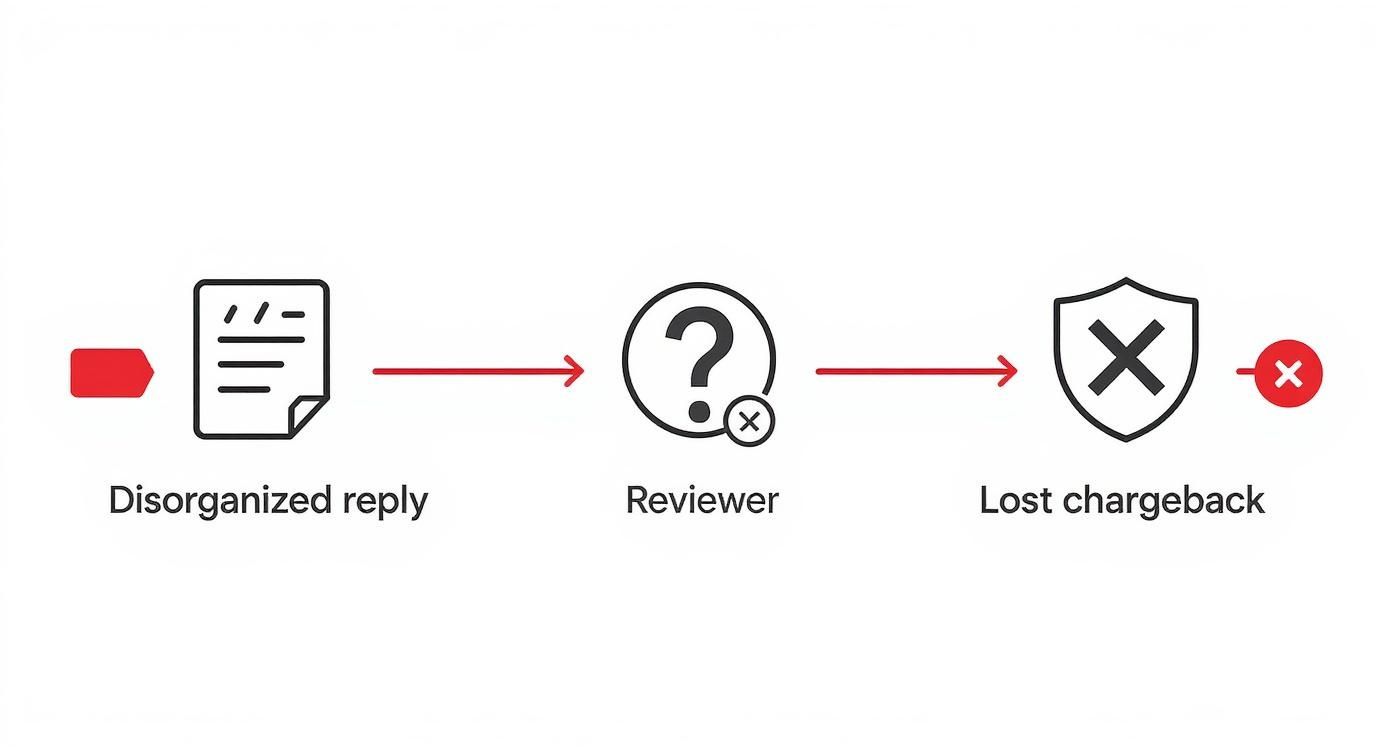
The takeaway here is simple: if the reviewer is confused, the cardholder almost always wins. That’s why a clean, predictable format is completely non-negotiable.
The Key Structural Components
Every single high-impact rebuttal letter is built on the same solid foundation. This means organizing your information into clear, distinct sections that each serve a specific purpose. It’s how you transform a simple letter into a compelling legal document that demands to be taken seriously.
Let's break down the core parts you absolutely need:
- Case and Transaction Details: Get straight to the point. Right at the top, list the chargeback case number, transaction ID, date, and amount. Putting this info first allows the reviewer to immediately pull up the correct file without any guesswork.
- A Concise Opening Summary: This is your elevator pitch. In just one or two sentences, state who you are, what you're fighting, and why you’re right. For example: "We are contesting this chargeback because the evidence confirms the item was successfully delivered and signed for by the cardholder at the verified address."
- The Customer's Purchase Story: Briefly walk the reviewer through the transaction from start to finish. Describe how the customer found your site, what they ordered, and the steps they took to complete the purchase. This context helps paint a clear picture of a legitimate, intentional interaction.
This isn’t just theory; this structured approach flat-out works. In fact, some studies have shown that well-organized rebuttal letters have a much higher chance of winning compared to vague or messy responses.
Linking Your Evidence to Your Claims
Now for the most critical part of your letter: connecting your story to your proof. Never just attach a bunch of files and hope the reviewer figures it out. You need to explicitly point to each piece of evidence right there in the body of your letter.
A winning rebuttal letter acts as a guided tour of your evidence. It tells the reviewer exactly what to look at and what conclusion to draw from each document.
Use a simple, direct format to list your evidence and explain why it matters. By meticulously organizing your letter and guiding the reviewer step-by-step, you remove all guesswork and present a case that's impossible to ignore.
How To Craft a Point-by-Point Rebuttal Argument
This is where you make your case. You have to tackle the customer's claim head-on. A vague, generic denial just won't cut it; you need to directly address the specific reason they filed the dispute. The most effective way to do this is with a methodical, point-by-point response that systematically dismantles their argument.
The strategy is simple but powerful: state the customer's claim, then immediately counter it with your own direct, evidence-backed rebuttal. Don't bury your arguments in a dense paragraph. The goal is to make it ridiculously easy for a busy bank employee to see their claim, see your response, and see the proof.
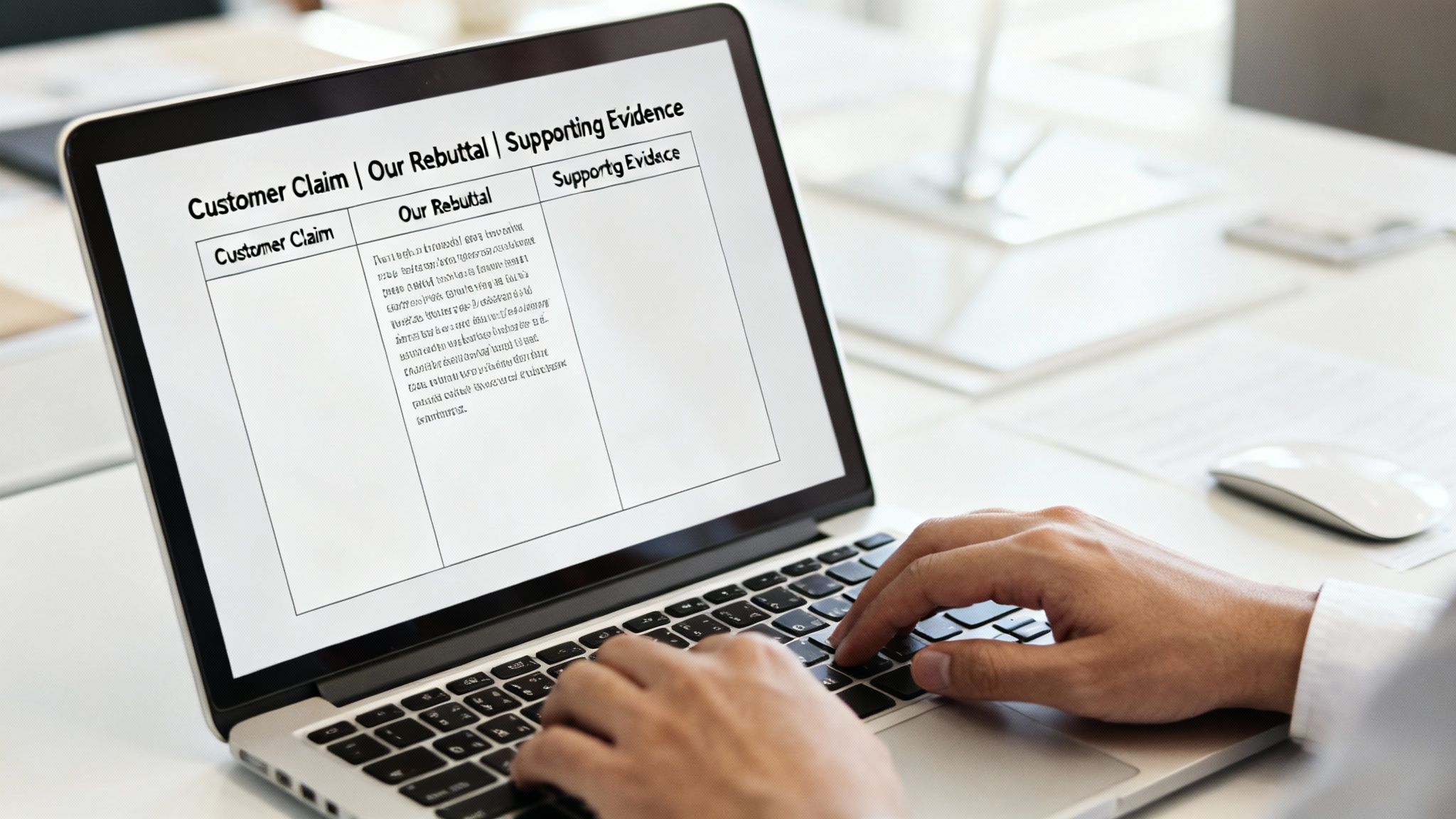
Use a Table for Ultimate Clarity
One of the best techniques for any format for rebuttal letter is to organize your argument into a simple table. It’s a game-changer. A table forces you to be concise and organized, presenting your case in a clean, logical format that’s impossible to misinterpret.
This approach transforms a potentially messy back-and-forth into a clear, professional presentation. You're showing the reviewer that you've thoroughly analyzed the claim and have specific, concrete evidence to disprove every single part of it.
You really only need a simple three-column layout. It's clean, direct, and gets the job done.
Here’s a simple structure you can use to map your response directly to the cardholder's claims. By linking each point to a specific piece of evidence, you make your case airtight and easy for the reviewer to follow.
Point-by-Point Rebuttal Structure
This clear structure ensures every part of your argument is supported and easy to find, leaving no room for ambiguity.
An Example in Action
Let's say a customer files a chargeback claiming they never received the product. Instead of writing a long, rambling paragraph, you can lay it all out like this:
This point-by-point method leaves zero room for misinterpretation. If you need more inspiration, check out these different rebuttal letter examples to see how this structure works for all kinds of disputes.
This methodical approach isn't just about presenting facts; it's about proving you've carefully considered and disproven each part of the customer's claim with specific, verifiable evidence. You're showing, not just telling.
By directly addressing each claim, you control the narrative and guide the reviewer logically through your evidence. You’re not just throwing a pile of documents at them; you’re building an airtight case that connects every piece of the puzzle. This organized approach is what turns good evidence into a winning chargeback reversal.
Gathering Compelling Evidence to Support Your Case
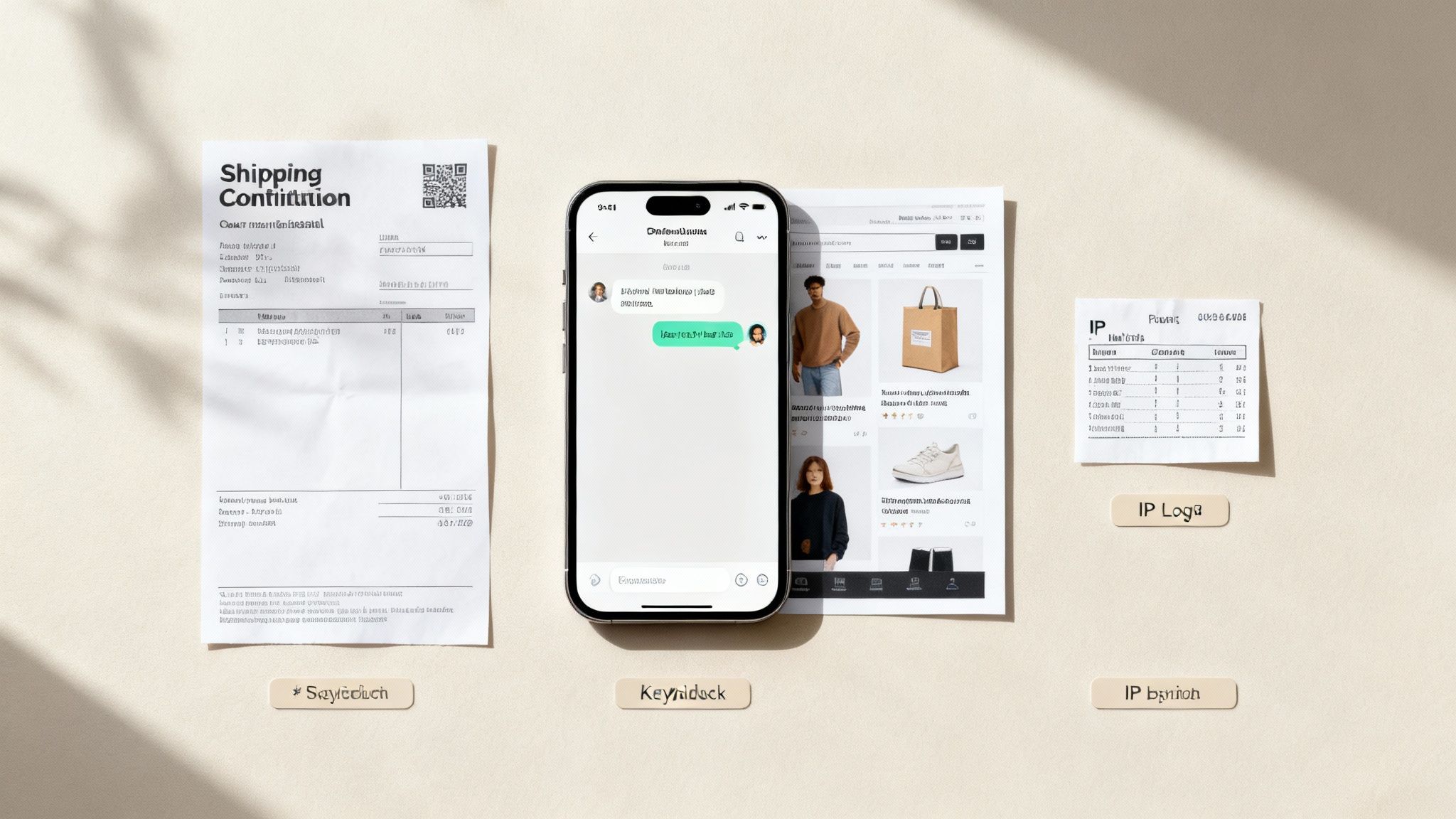
A perfectly written rebuttal letter is a great start, but let's be real—without solid proof, it's just your word against theirs. The evidence you pull together is the absolute foundation of your case. Your goal is to build a wall of undeniable proof that directly shuts down the customer's claim.
Think of yourself as a detective piecing together the story of the transaction. Simply providing a shipping confirmation often isn't enough to get the job done. You need to dig deeper to really make a difference in the outcome.
Core Transactional Evidence
First things first, you have to cover the essentials. These are the non-negotiable documents that prove a legitimate transaction occurred. Without these, your case is on shaky ground from the get-go.
- Order and Transaction Details: This is your starting point. Include the order date, the exact amount, the transaction ID, and the customer’s billing information.
- Shipping and Delivery Confirmation: Don't just show you sent it; you need proof it arrived at the verified address. If you have signature confirmation, that’s gold. Seriously, it can win the case on its own.
- AVS and CVV Match Results: This is crucial for fighting "unauthorized transaction" claims. Show that the address verification system (AVS) and card verification value (CVV) checks passed.
This baseline evidence establishes that a real order was placed and a product was delivered. Now, you’ll start adding more specific layers of proof to tailor your defense to the dispute reason.
A common mistake merchants make is assuming the bank will connect the dots. They won't. Your job is to present the evidence so clearly that it leads them to one, single conclusion: this chargeback is invalid.
Beyond the Basics: Customer Interaction Proof
This is where you can build a truly powerful case. Customer communications and their digital footprints often hold the smoking gun because they show intent and confirm they received the product. This part of the chargeback representment process is something far too many merchants skip over.
It's time to do some digging for these game-changers:
- Customer Service Communications: Pull up every email, support ticket, or live chat log you have with the customer. A customer asking for help using a product they later claim they never received? That's incredibly strong evidence.
- Digital Footprints: For digital goods, this is everything. Provide IP logs showing the download or login came from the customer's known location. Even for physical products, showing the order IP address matches the shipping city is a powerful piece of the puzzle.
- Social Media Posts: You'd be surprised how often this works. Customers will sometimes post photos or comments online with the very product they claimed was "not delivered" or "not as described." A quick search of their public profiles can sometimes win you the case instantly.
- Policy Screenshots: Always, always include screenshots of your terms of service, refund policy, and the product description page as they looked at the time of purchase. This proves the customer agreed to your terms and knew exactly what they were buying.
When you combine all these different types of evidence, you're not just sending documents; you're painting a complete picture of the transaction that makes the cardholder's claim look weak. This detailed approach is what separates a losing rebuttal from a winning one.
Mastering a Professional Tone in Your Letter
How you say something in your rebuttal letter is just as important as what you say. It's incredibly easy to get frustrated when a chargeback notice lands in your inbox, but letting that emotion bleed into your writing is a surefire way to lose, no matter how strong your evidence is.
An emotional or accusatory letter immediately torpedoes your credibility. The goal here is to be firm, factual, and completely objective. You're not firing off an angry email; you're submitting a formal business document that needs to project confidence and cooperation, not conflict.
Stay Objective and Fact-Based
The person reviewing your case is a neutral third party. They don't know you, and they don't know the customer. Your one and only job is to present the facts so clearly that they have no choice but to side with you. That means avoiding any language that attacks the customer or complains about the process.
Let's look at an example.
- This will lose: "The customer is obviously lying about not receiving the package just to get a free product."
- This can win: "We are contesting this chargeback, as the evidence confirms the order was successfully delivered to the cardholder's verified address."
The winning example sticks to the facts and points directly to the evidence. That’s exactly what a case reviewer wants to see. A professional demeanor is critical, and these principles are useful well beyond just chargebacks. In fact, you can find great strategies for professionally handling dissatisfied customers that apply here.
Think of your letter as a legal document, not a personal message. Every single sentence should serve one purpose: to logically and calmly prove your case using verifiable evidence.
Use Confident and Clear Phrasing
Your choice of words can project confidence and steer the reviewer's interpretation of your evidence. Ditch weak or passive language and use direct, assertive statements that leave no room for doubt. You want to sound like you're in complete control of the facts—because you are.
Here are a few phrases that work wonders:
- "As the evidence demonstrates..."
- "The attached documents confirm..."
- "The transaction details validate..."
- "This directly refutes the cardholder's claim that..."
This kind of language immediately establishes your credibility. A proper rebuttal letter also includes a formal salutation and structure, which reinforces this serious, professional tone. This whole approach shows you respect the process and have your ducks in a row, which can absolutely influence the final decision.
Platform-Specific Tips for Shopify and PayPal
Submitting a rebuttal letter isn’t a one-size-fits-all process. The platforms you sell on have their own unique quirks, and knowing the ins and outs is half the battle. What works on one might completely fall flat on another.
Shopify and PayPal, for example, have their own portals and prioritize different types of evidence. Learning to work with their systems instead of fighting against them can seriously improve your chances of winning.
Nailing Your Shopify Submission
Shopify’s dispute management system is pretty user-friendly, but how you use it makes all the difference. When you get that chargeback notification, resist the urge to just dump all your files into a single, massive PDF. Shopify lets you categorize your evidence, and you should absolutely take advantage of that.
Here’s where to focus your energy:
- Leverage Shopify’s Fraud Analysis: Every order comes with a built-in fraud risk assessment. If the analysis was "low risk" and all the flags were green, take a screenshot. Including this shows the card issuer you did your due diligence before fulfilling the order.
- Keep Your Documents Separate: Don't lump everything together. Upload your proof of delivery, customer emails, and product page screenshots as distinct, clearly labeled files. This makes life much easier for the person reviewing your case, allowing them to quickly find what they need.
A solid understanding the Shopify platform will help you frame your arguments in a way that resonates with their review process. Remember, inside their system, clarity and organization are your two best friends.
Winning Disputes in PayPal’s Resolution Center
PayPal plays by a slightly different set of rules. Everything happens in their Resolution Center, and they put a massive emphasis on their own Seller Protection policy. To have any shot at winning, your evidence has to align perfectly with its requirements.
PayPal is obsessed with one thing above all else: proof that you shipped the item to the exact address listed on the "Transaction Details" page. If you accommodate a customer's request to ship to a different address, you've likely just voided your Seller Protection.
Your top priority should be providing proof of delivery from your carrier that clearly shows the shipping address is an exact match to what PayPal has on file. No exceptions. If you're selling digital goods, you'll need to show proof of download or evidence of usage that's tied directly to the buyer's account information.
Because PayPal's policies can be so specific and rigid, it pays to know their playbook inside and out. We cover the nitty-gritty details in our guide to PayPal chargebacks. Stick to their script, and you'll have a much stronger chance of winning.
Even after you’ve got a solid game plan, a few questions are bound to pop up. Let’s run through some of the most common ones we hear from merchants who are just getting started with their chargeback rebuttals.
How Long Should My Rebuttal Letter Be?
One page. That's it. If you can keep it to a single page, you're golden.
Remember, the person reviewing your case at the bank is swamped. A short, powerful letter that gets right to the point is way more effective than a multi-page essay. The goal is to make it incredibly easy for them to say "yes" to you, not bury them in paperwork.
Can I Use the Same Letter for Every Dispute?
Please don't. This is one of the fastest ways to lose.
Every single chargeback comes with a specific reason code, and your rebuttal has to tackle that exact claim head-on. Sending a generic, copy-pasted letter that doesn't match the reason for the dispute is a guaranteed loss. Customizing your response isn't just a good idea—it's absolutely essential.
The most effective format for a rebuttal letter is one that is tailored specifically to the customer's claim. One size never fits all in the world of chargebacks.
What’s the Single Biggest Mistake to Avoid?
Letting your emotions get the best of you. It’s completely understandable to feel frustrated—especially when you know it's friendly fraud—but letting anger or sarcasm seep into your letter is a huge mistake.
It instantly kills your credibility. Stick to the facts, stay objective, and let your evidence do all the talking. A calm, professional tone shows the reviewer you're serious and helps build a case in your favor.
Don't let chargebacks drain your revenue and waste your time. ChargePay uses AI to automate the entire rebuttal process, from generating evidence-backed letters to submitting them on your behalf. Stop fighting disputes manually and start winning them automatically. Reclaim your revenue with ChargePay today.

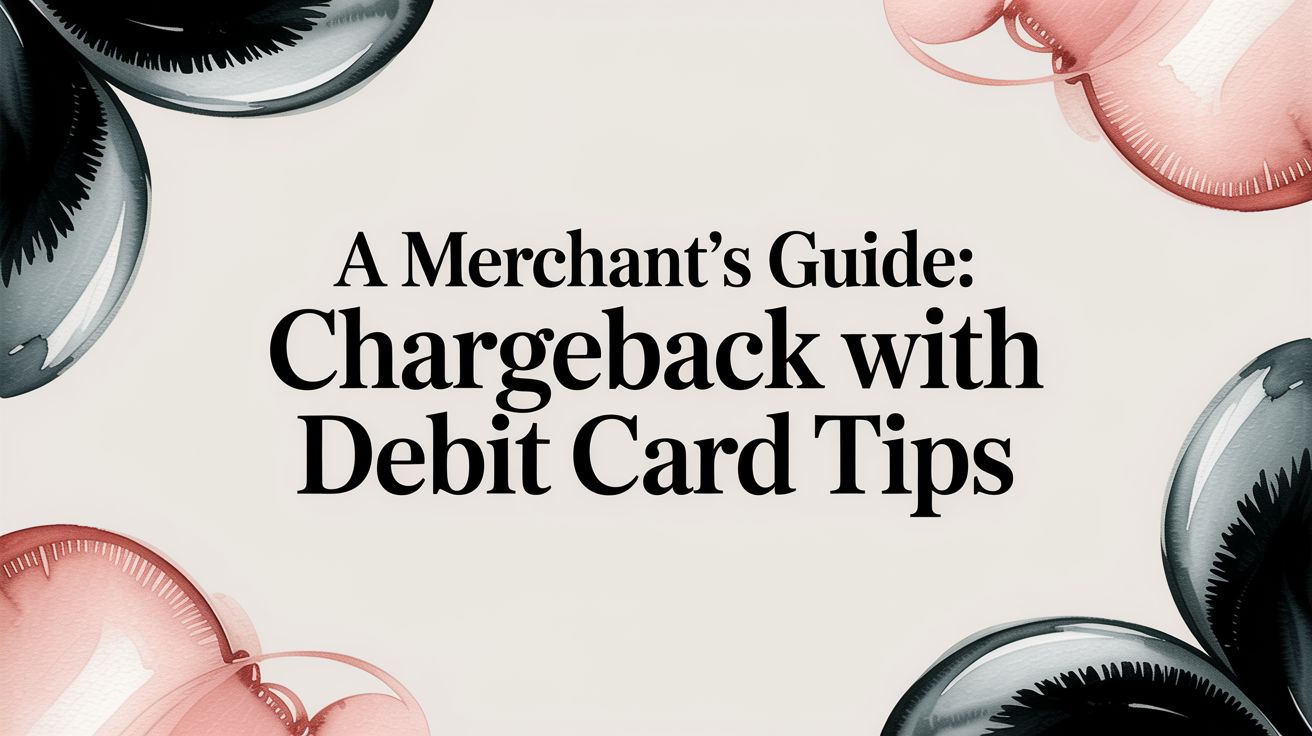

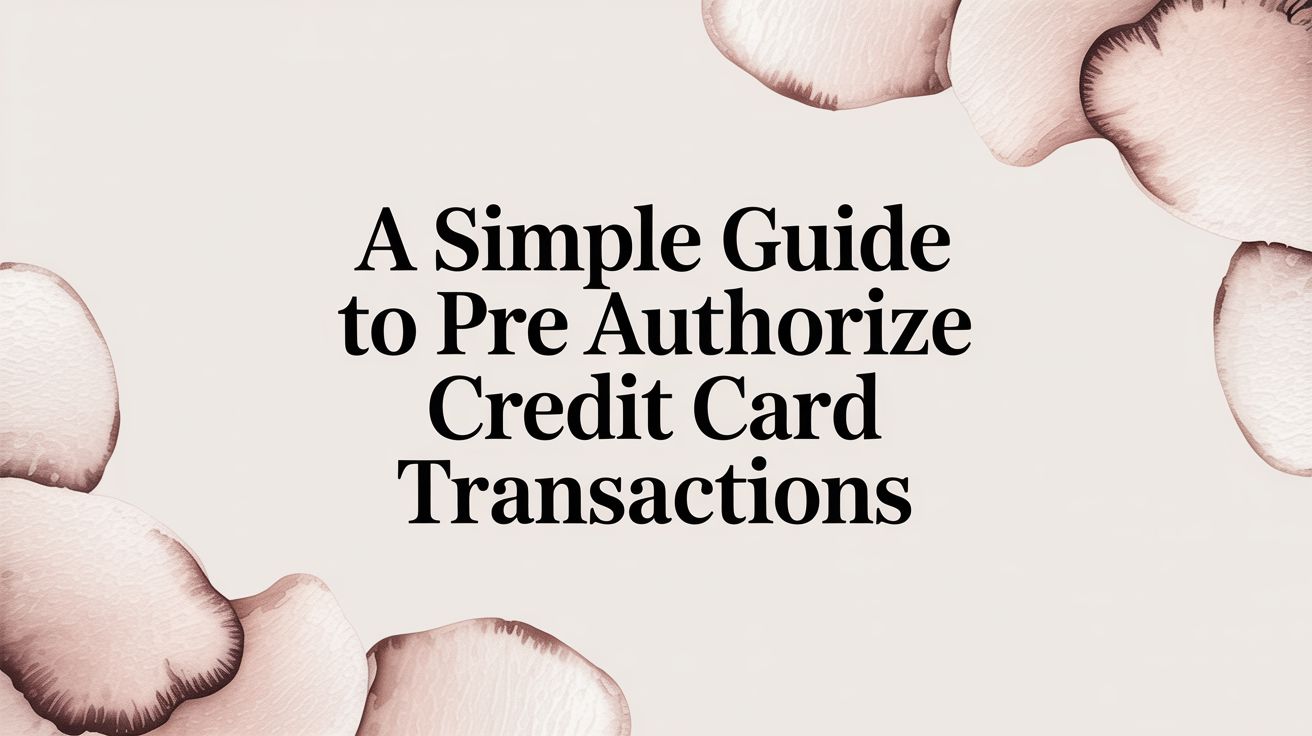


.svg)







.svg)
.svg)
.svg)